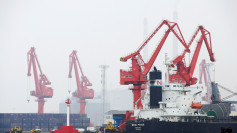For the first time in as many years, China's two major provinces - Guangdong and Jiangsu - were expected to earn more than 10 trillion yuan ($1.45 trillion) with their respective gross domestic products
While most of China's provinces have adjusted their economic growth targets lower this year, Guangdong and Jiangsu's GDPs are projected to rise, the China News Service reported.
Based on their government document reports, at least 26 of the 31 province-level regions in China had reported their gross local output for 2019 as of January 15 this year, including yearly growth targets for the current fiscal year.
Jiangsu saw a GDP growth of 6.4 percent from the previous year, and it was also projected that the region will hit a total GDP volume of over 10 trillion yuan.
Guangdong's gross local figures, on the other hand, posted an expected rise of 6.3 percent year-on-year, reaching the 10.5 trillion yuan mark -- the first time a Chinese province has joined the 10 trillion yuan club.
While the two provinces were up in the rankings, other provinces generated their own impressive GDP rally: Zhejiang earned 6 trillion yuan in 2019, an increase of 6.8 percent, based on estimates by government work reports.
Faced with headwinds in local and international trade and rising global uncertainties, a big number of Chinese provinces were estimated to trim down their growth targets from last year.
Henan's economy generated 5 trillion yuan, soaring more than 7 percent in contrast to the previous year, and Hubei's gross domestic figures were pegged at 4 trillion yuan, with growth staying robust at 7.8 percent.
Guangdong, Beijing and Shanghai and all eased their GDP goals to roughly 6 percent, down moderately from 6 to 6.6 percent the year before.
China's Development and Reform Commission director Li Kanzhen stated that as the Chinese government feels the rising pressure brought about by growing external challenges, GDP growth targets of 6 percent will help lifts its economic growth, the China News Service said.
Meanwhile, five provincial level regions, namely the Hebei, Chongqing, Xinjiang Uygur autonomous region, Inner Mongolia and Jilin, have all kept their GDP targets unchanged from the previous year.
Although most provinces have reduced their respective economic growth forecasts, Tianjin, elevated its goal from 4.5 percent to 5 percent.
Tianjin Mayor Zhang Guoqing pointed out that the city is currently in a fragile situation, with the country's economy facing different challenges, internally and externally, and with overall social development still reeling from last year's financial stresses.






